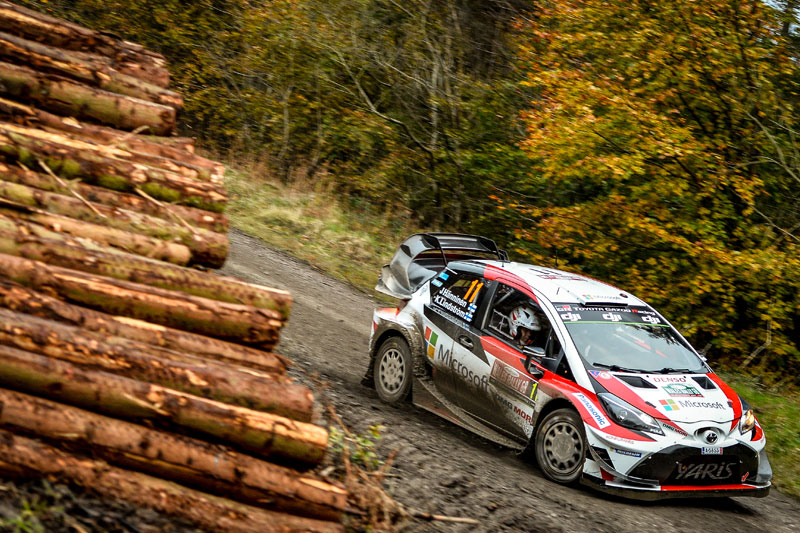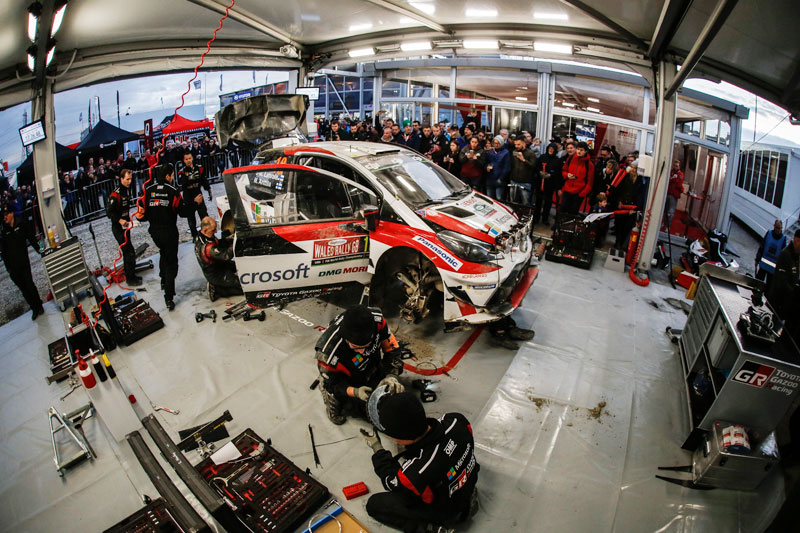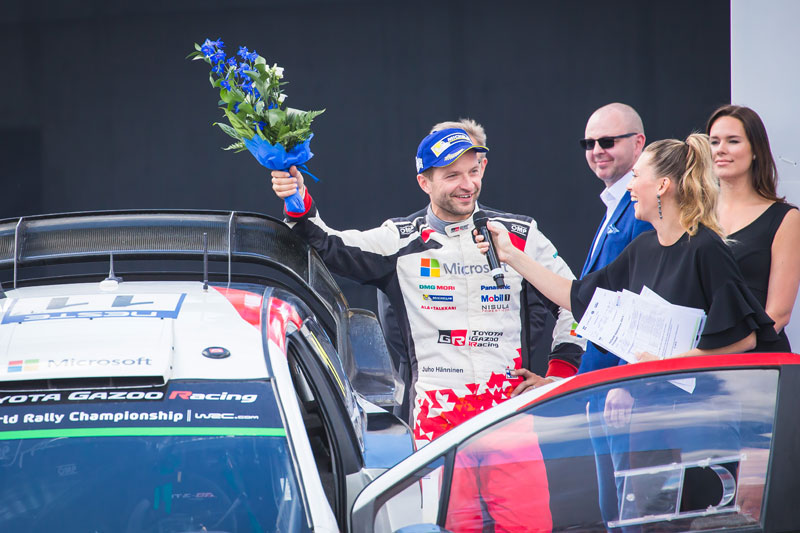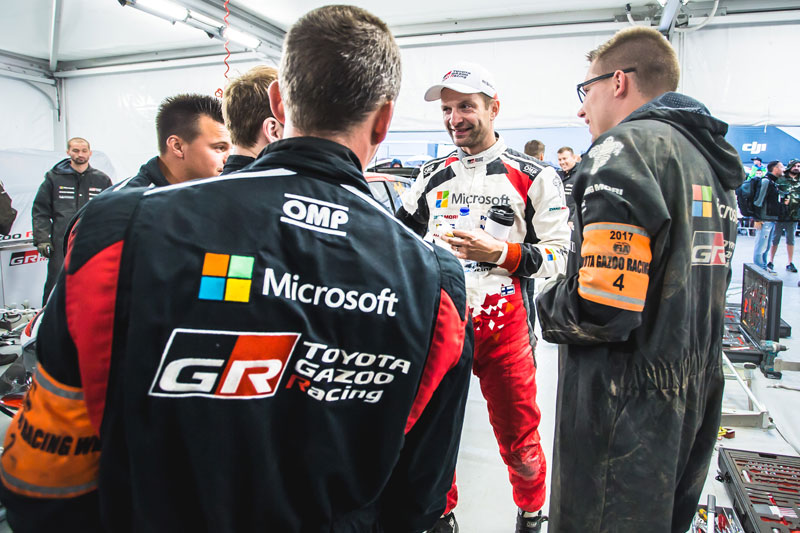RALLY GB

The Yaris WRC encounters unexpected difficulties at this traditional gravel rally; yet, on the Welsh dirt roads, the team identifies clues essential for further progress
“Four seasons in a single day”
British weather is extremely changeable, and many people leave their houses with umbrellas even when skies are clear. With its complex topography, Wales is said to have particularly unpredictable weather. Past editions of Rally GB, which takes place primarily in Wales, have experienced a variety of different conditions including rain, fog, and hail.
The levels of tire grip on Welsh gravel SSs differ vastly depending on whether conditions are dry or wet. When completely dry, traction is extremely high, and the cars corner at incredible speeds. When it rains, however, the gravel becomes waterlogged, and the previously firm road surface turns into mud. As a result, grip levels drop dramatically, and cornering speeds likewise fall. It is no simple task to optimize the car for both sets of road conditions; to make matters worse, the driving conditions for Rally GB SSs are not found in any country other than the United Kingdom.
The TOYOTA GAZOO Racing World Rally Team conducted its pre-event tests in the area just one week before the rally. At this time of year, it is usually cold in Wales with frequent rain. However, conditions during the tests were not what the team expected: on some days it was even warm enough to wear t-shirts, and rainfall was sporadic. In these conditions, the Yaris WRC handled superbly. And, while the team was somewhat concerned at not having had a sufficient run-out in cold, wet conditions, they headed into the rally itself having prepared as best they could.
The drivers are bewildered by road conditions that differ considerably from pre-event tests
When the rally started, however, the course conditions on each SS were different to the pre-event tests. Road surface temperatures were low, and the gravel contained high levels of moisture. Since the weather was good, the surface was dry on some parts of the course. However, since it was still wet beneath the surface, the gravel was gradually churned up as multiple rally cars drove through. The surface became extremely muddy, and grip levels fell significantly as a result. Of added concern was the fact that grip levels varied wildly even in the course of a single SS. It would be easy for the team to respond, for example, if grip levels were low throughout the SS. However, since conditions would often alternate between good traction and sudden skidding, it was difficult for the team to decide whether to optimize the car for high or low levels of grip, and it was difficult for the drivers to gauge the best way to drive. The huge difference in course conditions during the test and during the rally itself bewildered the drivers, too. They were dogged by understeer—where the Yaris WRC would not turn as well as they would like into the corner—and suffered from a lack of traction.
The drivers continue to battle in disadvantageous conditions
Unfortunately, there was no designated service period scheduled for Day 2, when the true gravel SSs began. The team was therefore unable to make major setup changes during the day, and the drivers were only able to adjust damping forces and vehicle height. Although minor setup adjustments resulted in improved handling, there was no fundamental resolution to the difficulties experienced by the drivers, and they were forced to persevere. Even in such relentless conditions, however, each of the drivers did their best. Jari-Matti Latvala finished Day 2 in fifth position, for example, and did his best to extract the utmost performance from his vehicle.
The team encounters unexpected issues on the Welsh muddy roads
The team worked on the Yaris WRCs at the end of Day 2 and, on the following day, the cars demonstrated significantly improved handling. But it was still not enough. The settings required at Rally GB were of a complexity not found at other gravel rallies, and it was not easy to identify the optimal setup. On extremely muddy courses, large amounts of mud gradually accumulated on the fenders and lower parts of the vehicle, increasing the weight of the cars. However, the mud did not simply make the cars heavier—they altered the fore-aft weight distribution, and this had a major impact on the handling of the vehicles. If mud accumulated at the back of the Yaris WRC, for example, then the weight distribution would shift to the rear; this would lighten the load on the front wheels which, in turn, would lead to understeer. Such symptoms are rarely encountered in dry conditions. However, only by considering such eventualities would the team be able to compete for victories in the WRC. What the team lacked at Rally GB was, first, actual rally experience in Wales and, second, the ability to respond to changes in driving conditions.
The team’s greatest success is the ability to identify its deficiencies
It was a major boon to the team that they were able to identify what they lacked, and at least partly make up for this deficiency before the rally finished. On Day 3, Latvala upped his pace and rose to fourth overall, just 4.1 seconds behind third place. On the tricky Welsh gravel roads, the team had found an important clue to improving the vehicle. Latvala eventually finished fifth and Esapekka Lappi ninth. This was a disappointing result when considering the abilities of the drivers and the potential of the Yaris WRC. However, the team had managed to gather extremely valuable data and experience that was, in a way, more important than the drivers’ final placings. There is no doubt that this was an extremely meaningful rally for the future of the team.
Hänninen’s final rally ends in disappointment
This year’s edition of Rally GB was Juho Hänninen’s final rally for the TOYOTA GAZOO Racing World Rally Team. Despite again struggling to adapt to the car and the course, he continued to put in reliable performances on a difficult, slippery course. On Day 3, after successful changes to the setup of his car, Hänninen increased his pace. He rapidly raised his level of performance, recording the fifth fastest time on SS10 and the second fastest on SS11. However, on SS14, a short, tarmac stage, Hänninen mistimed his braking and crashed into a hay bale, damaging the suspension and body of his Yaris WRC. Due to the significant damage, the car was unable to be repaired, so he was regretfully forced to retire from his final rally of the season.
Spurred on by Hänninen’s support, the team will continue to fight
Although Hänninen had limited actual rally experience in a WR car, he was able to demonstrate magnificent pace in a number of rallies this season. Notably, he clinched his first podium in the second half of the season at Rally Finland, and, at the tarmac Rallye Deutschland, he recorded the fastest time on the longest and most difficult SS. His fourth-place finish in Germany was the highest of any TOYOTA GAZOO Racing driver, and he secured a splendid fourth again at the following rally in Spain. Hänninen worked hard every day despite being one of the older drivers in WRC, and his continual efforts to improve had an extremely positive influence on the team.
Hänninen was the first driver to drive for the TOYOTA GAZOO Racing World Rally Team after its establishment, and he played an important role during the early development of the Yaris WRC. The team engineers praised Hänninen’s major contribution to the team: “Juho has a very natural driving style, and he is extremely adept at providing feedback on the vehicle. The Yaris WRC would not have such strong basic performance were it not for his involvement in the early stages of development. It is difficult to put into words just how important Juho’s contribution has been to the team.” But it was not just the engineers—the entire team praised Hänninen’s efforts. The Toyota GAZOO Racing World Rally Team will go to Rally Australia with just two vehicles. However, Latvala and Lappi will compete at the final rally of the season in a Yaris WRC that incorporates Hänninen’s experience and best wishes.
RESULT
| Pos | Driver | Co-Driver | Vehicle | Time |
|---|---|---|---|---|
| 1 | Elfyn Evans | Daniel Barritt | Ford Fiesta WRC | 2h57m00.6s |
| 2 | Thierry Neuville | Nicolas Gilsoul | Hyundai i20 Coupe WRC | +37.3s |
| 3 | Sebastien Ogier | Julien Ingrassia | Ford Fiesta WRC | +45.2s |
| 4 | Andreas Mikkelsen | Anders Jaeger | Hyundai i20 Coupe WRC | +49.8s |
| 5 | Jari-Matti Latvala | Miikka Anttila | Toyota Yaris WRC | +50.3s |
| 6 | Ott Tanak | Martin Jarveoja | Ford Fiesta WRC | +1m02.3s |
| 7 | Kris Meeke | Paul Nagle | Citroen C3 WRC | +1m20.5s |
| 8 | Hayden Paddon | Seb Marshall | Hyundai i20 Coupe WRC | +2m16.3s |
| 9 | Esapekka Lappi | Janne Ferm | Toyota Yaris WRC | +2m46.5s |
| 10 | Dani Sordo | Marc Marti | Hyundai i20 Coupe WRC | +3m50.5s |
| Ret | Juho Hänninen | Kaj Lindström | Toyota Yaris WRC |









